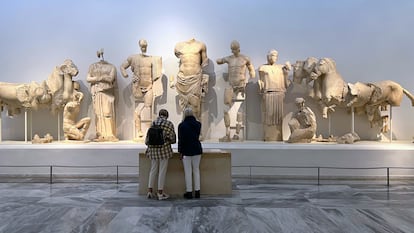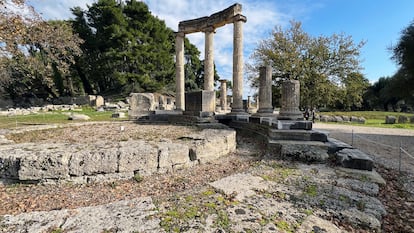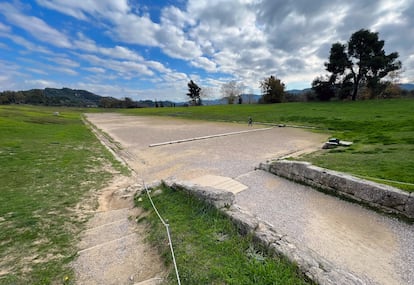Olympia: A visit to Greece’s most athletic ruins
A tour around the city dedicated to the god Zeus, where the famous competition took place for over a millenium

They may not be the most spectacular ruins in Greece. But they are, without a doubt, the ones that have received the most attention. Agamemnon’s tribulations, the fall of the Byzantine Empire and the peculiarities of Mycenaean architecture may mean nothing to a common mortal, but who hasn’t spent a hot afternoon before the television watching the Olympic Games? In the east of the Peloponnese peninsula lie the ruins of Olympia, the city dedicated to Zeus, where the Olympics were celebrated for over a millennium. Today, they are a favored destination for sports lovers and the general public.
Modern Olympia is an unremarkable town of four streets and 800 residents who live off the tourism generated by the nearby historic site. Dozens of hotels, restaurants and souvenir shops cater to the hundreds of thousands of visitors who arrive each year. Ancient Olympia’s attractions consist of three sites, whose exploration could take a long morning or a leisurely day: the archeological site, the Museum of the History of the Olympic Games of Antiquity and the Archaeological Museum of Olympia. The three locations are contiguous, and visitors can enter each of them with a single ticket that costs €6 and can be purchased at the door of each site. There is a fourth museum, the Museum of the History of the Excavations at Olympia, which requires a separate ticket.

I recommend starting at the Museum of the History of the Olympic Games of Antiquity. It is not spectacular, but it gives a general idea of the site and of what occurred there between the year 776 BC, when the king Iphitos of Elis inaugurated the first games, and the year 394 AD, when emperor Theodosius I the Great, a Christian, abolished them for being pagan. Years later, his grandson, Theodosius II, even less tolerant of paganism than his grandfather, had the city of Olympia destroyed.
Aside from seeing archeological artifacts, the museum includes a fantastic mosaic with motifs of athletes, which is almost completely conserved. You will learn curious facts, such as that the predecessor of the modern Olympics’ inaugural parade was the sacred procession that marched from the city of Elis – the capital of the city-state of Elis– and covered 300 stadia, or 58 kilometers, to Olympia. Its participants included the hellanodikai (judges), the priests and rulers of Elis, the athletes with their trainers and riders with their mounts and their chariots, followed by numerous visitors and pilgrims attracted by the festivities and the animals to be sacrificed. Only when the procession arrived at Olympia, after two days of marching, were the Games declared inaugurated. They were held every four years – an Olympiad – coinciding with the second Moon after the summer solstice. They brought together athletes from all the city-states of Greece, who, for a few days, left internal struggles and wars behind to compete in peace and harmony. The Sacred Truce, a cessation of hostilities in the war-torn Hellenistic world, was declared. The Sacred Truce was so respected by all that in the 1,169 years that the Games lasted, not once were they suspended or delayed.
The museum will also teach you that women were prohibited not only from participating in the event, but also from being present as spectators. Anyone who violated the order was thrown off a cliff. The only woman on record who attended a competition and came out unscathed was Kallipateira of Rhodes, daughter and mother of famous Olympic champions, who, in the Games of the year 396 BC snuck in to see her son participate in and win the boxing championship. She was pardoned out of respect for the Olympic glories achieved by her family. There were also children’s competitions. The most popular sports were boxing, wrestling and chariot racing. Another condition was that the athletes had to be Greek, of Greek parents and free men: slaves were also banned from entering.
From the History Museum, visitors can continue along a pleasant tree-lined walkway to the entrance to the ruins. Considering the viciousness of the demolition crew sent by Theodosius II, and the effects of several earthquakes in the sixth century, it is surprising how much there is still left of the once-lavish Olympia. The ruins were covered by a layer of more than six meters of earth until they were rediscovered at the end of the 18th century.

The first thing that appears is the sanctuary of Olympia, which is currently under excavation. Behind it is the arena, an enormous quadrangular patio where participants trained in boxing, wrestling and jumping. It was surrounded by arcades and rooms where the athletes undressed and anointed themselves with oils. Poets and scholars also used the arena to read their odes and manifestos. It is one of the best preserved and most recognizable structures. To the left of the arena stands what remains of the Philippeion, the circular temple of the Ionic order ordered built by Philip II, the Macedonian king and father of Alexander the Great. It is the most photogenic structure of what is left of Olympia, because it was partially rebuilt in 2005 by the team of German archaeologists that has carried the weight of the excavation since its inception.
There were also dozens of temples and facilities of which hardly any stones remain. The most impressive of all is the temple of Zeus, the largest and most magnificent of the entire site, where the famous statue of the father of all the gods was sculpted in gold and ivory. It was considered one of the Seven Wonders of Antiquity. The statue was sculpted by Phidias, the most famous sculptor of classical Greece, in a workshop that archaeologists discovered close to the temple and in which several of his tools emerged. The building was later converted into a Christian basilica. I don’t know if the destruction of the temple of Zeus in Olympia was the work of man or earthquakes, but all its pieces – columns, capitals, plinths, beams– are complete and scattered on the ground, like a broken puzzle crying out to be restored. (Lack of funding, I suppose.)
Unfortunately, the most sought-after site in ancient Olympia is the most disappointing: the stadium. One might suppose that, in a city created for the celebration of sporting events, with fabulous temples built with the best marbles, the place that should host the object of all that assembly – that is, the sports events – would be the most spectacular of all. Well, no. The Olympia stadium never had stone steps or a noteworthy podium. It was and is an esplanade 192.27 meters long by 28.50 meters wide, surrounded by slopes whose grass once accommodated up to 45,000 spectators. The only fixed structure was a box on the southern flank from where the judges (hellanodikai) evaluated the competitions. Even so, it is impressive to go down to the track, symbolically run a hundred meters and feel, in the nakedness of the surroundings, the shouting and excitement of millions of spectators who gathered there for 10 centuries, anointed by the same spirit with which the modern Olympic Games are celebrated today: teamwork, solidarity, tolerance and peace between nations through sport.

On August 18, 2004, exactly 1,611 years after the last event, the Olympic Games returned to this stadium during the Games in Athens. Around 15,000 spectators seated on these grassy slopes had the honor of attending a shot put competition free of charge, scheduled here as a tribute to the site that saw the birth of the Games, in a day –according to the attendees – full of symbolism and emotions.
Although you may now be tired of so much stone and history, you should end your visit at the Archaeological Museum of Olympia, located in a newly built white building in another corner of the enclosure, next to the second parking lot.
It exhibits all the pieces that have appeared in excavations since the end of the 19th century: hundreds of vessels, statues, votive pieces, coins, shields, armor, helmets, bronze cauldrons and other gold and silver objects, in addition to true archaeological jewels, such as the Nike of Paeonios (a winged statue given by the Messenians and the Naupacts to the temple of Zeus with a tenth of the booty obtained in their war against the Spartans) and the Hermes of Praxiteles, who emerged among the remains of the temple of Hera. It also holds the two sculptural groups that decorated the friezes of the two facades of the temple of Zeus, which have been reconstructed almost in their entirety. The superb work exemplifies the magnificence that came to be destroyed – like so many other wonders of Antiquity throughout the world – due to intransigence and intolerance.
Sign up for our weekly newsletter to get more English-language news coverage from EL PAÍS USA Edition
Tu suscripción se está usando en otro dispositivo
¿Quieres añadir otro usuario a tu suscripción?
Si continúas leyendo en este dispositivo, no se podrá leer en el otro.
FlechaTu suscripción se está usando en otro dispositivo y solo puedes acceder a EL PAÍS desde un dispositivo a la vez.
Si quieres compartir tu cuenta, cambia tu suscripción a la modalidad Premium, así podrás añadir otro usuario. Cada uno accederá con su propia cuenta de email, lo que os permitirá personalizar vuestra experiencia en EL PAÍS.
¿Tienes una suscripción de empresa? Accede aquí para contratar más cuentas.
En el caso de no saber quién está usando tu cuenta, te recomendamos cambiar tu contraseña aquí.
Si decides continuar compartiendo tu cuenta, este mensaje se mostrará en tu dispositivo y en el de la otra persona que está usando tu cuenta de forma indefinida, afectando a tu experiencia de lectura. Puedes consultar aquí los términos y condiciones de la suscripción digital.
More information
Últimas noticias
Most viewed
- Alain Aspect, Nobel laureate in physics: ‘Einstein was so smart that he would have had to recognize quantum entanglement’
- Mexico’s missing people crisis casts a shadow over World Cup venue
- Why oil has been at the center of Venezuela-US conflicts for decades
- Trump clarifies who is ultimately in charge in Venezuela: ‘Me’
- Mexico seeks to shore up its defenses following US incursion in Venezuela











































